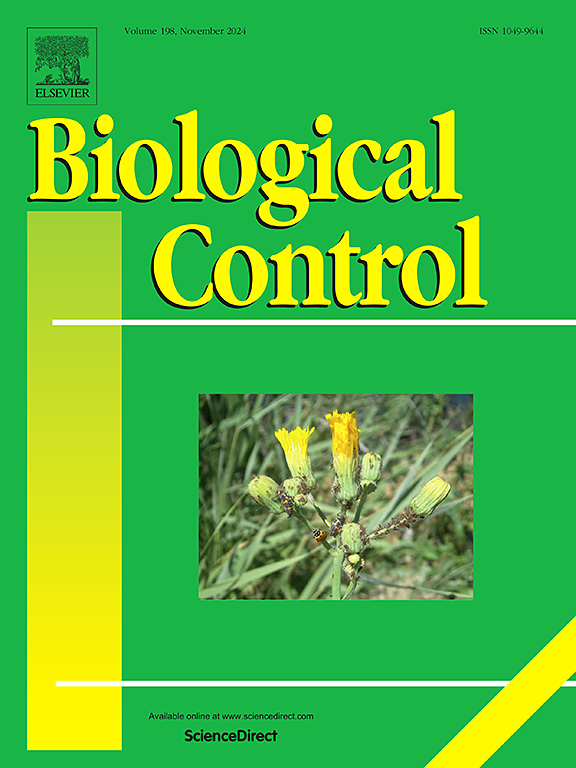Spatial distribution shifts of Batocera horsfieldi (Coleoptera: Cerambycidae) and its natural enemies in China under climate change: Implications for biological control
IF 3.4
2区 农林科学
Q2 BIOTECHNOLOGY & APPLIED MICROBIOLOGY
引用次数: 0
Abstract
With the increasing impact of climate change on global ecosystems, the ranges of species are undergoing significant changes. The aim of this study was to assess the potential suitable areas for Batocera horsfieldi (Coleoptera: Cerambycidae) and its natural enemies, Dendrocopos major (Piciformes: Picidae) and Scleroderma guani (Hymenoptera: Bethylidae), in the context of climate change and to explore the feasibility of pre-emptive classical biological control strategies. Predictions by ecological niche modelling combined with current and future bioclimatic factors showed that under future climate scenarios, the suitable areas for B. horsfieldi showed a gradual contraction, while the suitable areas for D. major and S. guani were expanding. In addition, by analyzing the overlap of the suitable areas of the three species, we found that in the future, there is a significant spatial overlap in the suitable distribution areas of natural enemies and pests, which provides new possibilities for biological control. This study provides new perspectives for pre-emptive biological control in the future, emphasizes the importance of screening and obtaining approval for releasing natural enemies after the arrival of the pest, especially in the context of the uncertainty caused by climate change, and provides a scientific basis for the development of integrated prevention and management strategies to deal with the threats posed by B. horsfieldi in the future. The results of this study can help to reduce the agro-ecological risks and promote the development of sustainable agriculture.
气候变化下中国马田天牛及其天敌的空间分布变化及其生物防治意义
随着气候变化对全球生态系统的影响越来越大,物种的分布范围正在发生重大变化。摘要本研究旨在探讨气候变化背景下马田蝙蝠(Batocera horsfieldi,鞘翅目:天牛科)及其天敌大树蛾(Piciformes: Picidae)和鸟硬皮蝇(Scleroderma guani,膜翅目:Bethylidae)的潜在适宜区,并探讨先发制人的经典生物防治策略的可行性。结合当前和未来气候因子的生态位模型预测结果表明,在未来气候情景下,白僵菌的适宜区呈逐渐缩小的趋势,而大黄僵菌和冠棘菌的适宜区呈不断扩大的趋势。此外,通过对三种植物适宜分布区的重叠分析,我们发现未来天敌和害虫适宜分布区存在明显的空间重叠,这为生物防治提供了新的可能性。本研究为今后的先发制人生物防治提供了新的视角,强调了在气候变化带来不确定性的背景下,在害虫到达后进行天敌筛选并获得批准释放的重要性,为今后制定综合防治策略以应对马氏白颊螟的威胁提供了科学依据。研究结果有助于降低农业生态风险,促进农业可持续发展。
本文章由计算机程序翻译,如有差异,请以英文原文为准。
求助全文
约1分钟内获得全文
求助全文
来源期刊

Biological Control
生物-昆虫学
CiteScore
7.40
自引率
7.10%
发文量
220
审稿时长
63 days
期刊介绍:
Biological control is an environmentally sound and effective means of reducing or mitigating pests and pest effects through the use of natural enemies. The aim of Biological Control is to promote this science and technology through publication of original research articles and reviews of research and theory. The journal devotes a section to reports on biotechnologies dealing with the elucidation and use of genes or gene products for the enhancement of biological control agents.
The journal encompasses biological control of viral, microbial, nematode, insect, mite, weed, and vertebrate pests in agriculture, aquatic, forest, natural resource, stored product, and urban environments. Biological control of arthropod pests of human and domestic animals is also included. Ecological, molecular, and biotechnological approaches to the understanding of biological control are welcome.
 求助内容:
求助内容: 应助结果提醒方式:
应助结果提醒方式:


